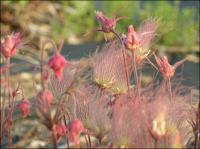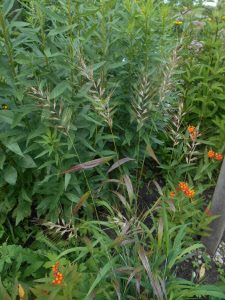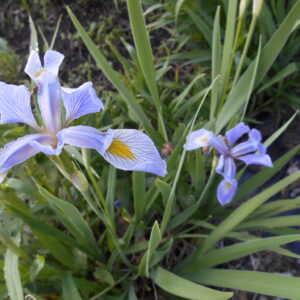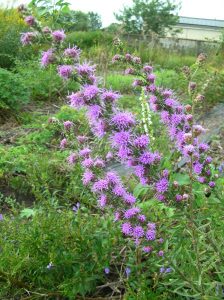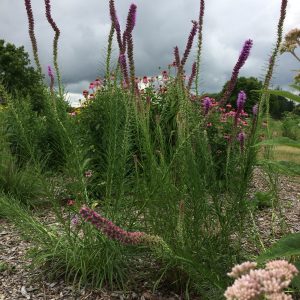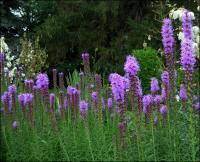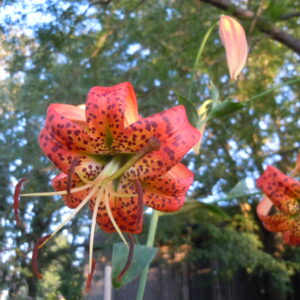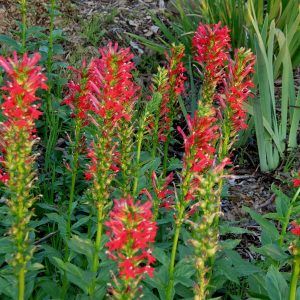Prairie Plants
Showing 49–56 of 85 results
-
Geum triflorum Prairie smoke, Old Man’s whiskers Z 1-8
Pale purplish-pink dangling cup-shaped flowers in spring to early summer, followed by hair-like, pink seed heads like the hair on a troll doll.
Pale purplish-pink dangling cup-shaped flowers in spring to early summer, followed by hair-like, pink seed heads like the hair on a troll doll.
Size: 10" x 8" but slow to grow to this width
Care: sun in well-drained to moist well-drained soil
Native: all of northern No. America, Wisconsin native
Awards: Great Plants for Great PlainsIntroduced to gardens in 1609. Many Native American medicinal uses. Blackfeet used it to cure coughs, skin sores and wounds on people and horses, swollen eyes, canker sores, and fuzzy thinking in people. Crushed, ripe seeds made a perfume. Okanagan-Colville women made a love potion from the roots, as well as curing vaginal yeast infections. The Eastern Cascades of Canada brewed a medicinal tea for eye-wash, sore throats and general aches from the plant. Sioux used it for many ailments: sore eyes, canker sores, sore throat, perfume, wounds, and added it to mixtures of plants for smoking Collected by Meriwether Lewis on June 12, 1806 on the Weippe Prairie, not far from the villages of the Nez Perce in Idaho.
-
Hystrix patula syn. Elymus hystris var. hystris Bottle brush grass Z 5-9
June thru fall bears 6” long spikes looking like bottle brushes
OUT OF STOCK- PLEASE EMAIL FOR AVAILABILITY
June thru fall bears 6” long spikes looking like bottle brushes.
Size: 2-3’ x 12-18”
Care: sun to part shade in dry to moist well-drained soil - tolerates dry shade
Native: Nova Scotia S to Virginia, W to ND and OK.
Wildlife Value: Birds eat seedsHystrix from the Greek (‘hedgehog’) meaning “with spikes” or “bristly” describing the flowers and patula means “spreading.” Collected before 1794. In 1913 L H Bailey wrote, “sometimes used for lawn decoration and for borders.”
-
Iris versicolor Blue flag Z 3-9
Purple, lavender or blue flowers in June
Purple, lavender or blue flowers in June
Size: 36" x 12"
Care: sun, moist to moist well-drained soil
Native: Eastern United States, Wisconsin nativeIris is named after the Greek goddess who accompanied the souls of women to the Elysian Fields by way of the rainbow. Her footprints left flowers the colors of the rainbow. Iris means the eye of heaven. Omaha Indians used the roots topically to cure earaches. Other tribes applied a poultice to cure sores and bruises. Root is poisonous. Cultivated in gardens since the 1700’s.
-
Liatris aspera Rough blazing star Z 4-9
Feathery purple buttons along tall spike
OUT OF STOCK
Feathery purple buttons along tall spike in late summer: August-October, after all other Liatris are done flowering.
Size: 24”-30” x 12”-18”
Care: Sun in well-drained soil
Native: So. Canada, much of eastern 3/4th of U.S.
Wildlife Value: attract butterflies (favorite nectar for Monarchs and Buckeyes) & hummingbirds.Aspera is Latin meaning rough. 1st collected by Frenchman André Michaux (1746-1802) who spent 11 years in America collecting hundreds of new plants.
-
Liatris pycnostachya Prairie blazing star Z 3-9
Tall, erect, purplish- pink spike in August-September
OUT OF STOCK
Tall, erect, purplish- pink spike in August-September
Size: 4’ x 1-2’
Care: well-drained soil in full sun
Native: central & SE US
Wildlife Value: deer resistant, attracts birds,& butterflies.Collected by French planthunter Andre Michaux in 1795 on the prairies of Illinois.
-
Liatris spicata Blazing star, Gayfeather, Button snakeroot Z 3-8
Rosy purple spikes in July and August, a flower arranger’s dream
Rosy purple spikes in July and August, a flower arranger’s dream
Size: 2-3' x 18"
Care: Full sun in moist to well-drained soil.
Native: Eastern and southern U. S., Wisconsin native
Wildlife Value: favorite nectar source for Buckeye butterflies & host for caterpillars of Painted lady, Fritillaries, Skippers, Sulphurs, Coppers & Checkerspot butterflies.Native Americans used roots medicinally for backaches, colic, dropsy and to strengthen a weak heart. The Dakota recognized this as an indication “when the flower is blue-red that corn is good to eat.” Nicollet Diary, August 13, 1838. The dried root reputedly repelled moths from stored clothes. First collected by English naturalist Mark Catesby and cultivated since 1732. Grown at America’s 1st botanic garden, Elgin Botanic Garden 1811.
-
Lilium superbum Meadow lily Z 4-8
Briliant orange with purple spots, turks-cap type lily blooming in late summer to early fall
OUT OF STOCK
Briliant orange with purple spots, turks-cap type lily blooming in late summer to early fall
Size: 10’ x 12”
Care: shade to sun in moist, acidic soil
Native: from VT to Fl & west to Mississippi River, incl. WisconsinLilium was named for the Greek word for smooth, polished referring to its leaves. Collected before 1762. Sold in America’s 1st plant catalog, Bartram’s Broadside, 1783. L.H. Bailey (1913): “The most magnificent and showy of native North American species, well worthy of extensive cultivation.” Found growing in moist meadows from Massachusetts to Indiana and Alabama. In 1665 John Rea called it the “Virginia Martagon,” In 1738 colonial botanist John Bartram sent it to his “brothers of the spade” in London where it caused a sensation. A challenge to grow, it demands well-drained, acid soil and plenty of moisture.
-
Lobelia cardinalis Cardinal flower Z 3-9
Ruby, cardinal red tubes with an upper lip split in half and a lower lip like a pixie’s apron encircle the spike up and down from August to October beckon hummingbirds to feed.
Ruby, cardinal red tubes with an upper lip split in half and a lower lip like a pixie’s apron encircle the spike up and down from August to October beckon hummingbirds to feed.
Size: 3’ x 12”
Care: sun to part shade in fertile, moist soil. Moist soil important
Native: Canada to Texas, Wisconsin native.
Wildlife Value: attracts hummingbirds
Awards: Received England’s Royal Horticultural Society Award of Merit & Missouri Botanic Garden Plant of Merit.Lobelia is named for Matthias L’Obel (1538-1616) French expatriate who immigrated to England and became physician to King James I. Cherokee cured stomach aches, worms, pain, fever, nose bleeds, rheumatism, headaches, colds and croup with Lobelia. They used the root to treat syphilis. In 1749 Swedish botanist Peter Kalm wrote that Indians used five species of Lobelia to cure venereal disease, “an infallible art of curing it.” Other Natives and colonists used the plant to induce vomiting. At the end of a funeral, Meskwaki Indians threw the dried and pulverized plant into the grave. Meskwaki also chopped the roots and secretly put it in the food of “a quarrelsome pair.” Allegedly “this makes the pair love each other again.” Tradescant the Younger (1608-1662) introduced this to European gardens when he sent it to England in 1637. Offered for sale in Bartram Garden’s 1783 Broadside. Grown by Washington at Mount Vernon and Thomas Jefferson at Monticello. Pressed specimen in Emily Dickinson’s herbarium.

